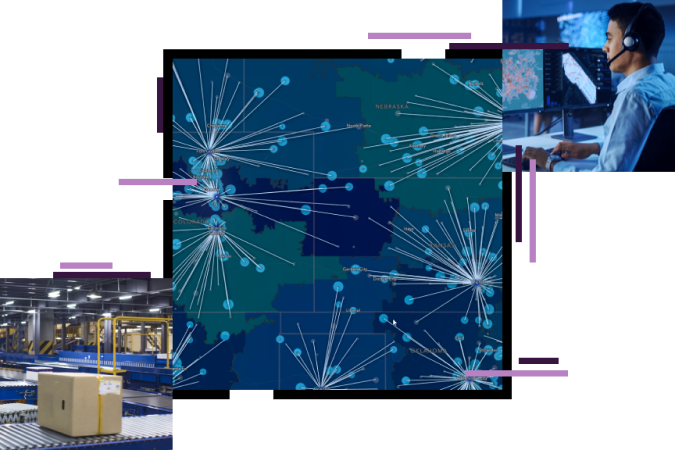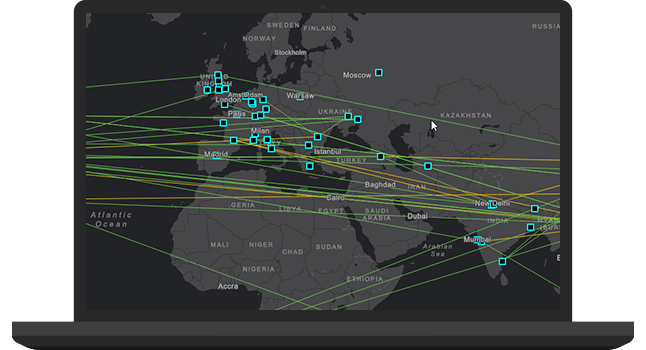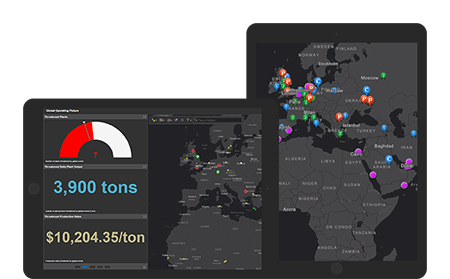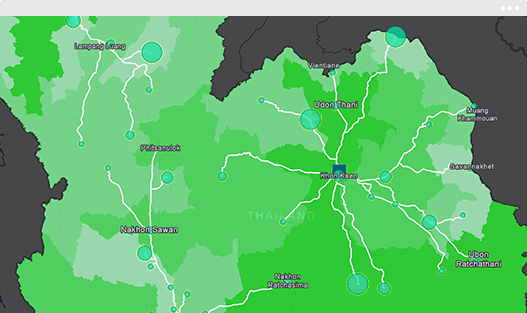
GM moves beyond dots on a map
General Motors puts its data to work to understand the competitive landscape. Robust spatial analytics gives 4,300 GM dealers insight into how to successfully meet local demand and grow business. Understanding customer preferences gives the company an edge in delivering excellent customer service.
Outperform the competition
Intelligent mapping and analytics drive informed decisions. Get a competitive advantage with Esri’s ArcGIS technology. Use real-time product performance tracking and advanced analytics to increase market share. Visualize supply chain workflows, efficiencies, and risks. Improve customer satisfaction, and outpace competitive threats throughout global markets.

Geospatial Analytics
Gain the ability to foresee where market opportunities and threats may develop. Combine live data trends with past patterns to realize growth and efficiency and mitigate risk.
Data-Driven Insight
Collect and overlay disparate data. Uncover hidden intelligence within sales figures, marketing campaigns, and complex supply chain operations.


Real-Time Situational Awareness and Alerting
Empower staff to collect, view, and share real-time information. Rapidly respond to supplier, product, and customer situations—anytime, anywhere, on any device.
EXPLORE A REAL-LIFE SCENARIO
Executives need to find new opportunities to grow market share
A manufacturing company’s marketing strategists and sales managers use spatial analytics to quickly examine potential high-performing markets. They correlate proven demographic patterns, sales trends, marketing mix, and other data such as regulatory compliance. Maps and geospatial analysis give this team an advantage—they will reach the best markets ahead of competitors.
EXPLORE A REAL-LIFE SCENARIO
Meanwhile supply chain managers examine a live detailed global operating picture.
The managers visualize all aspects of the supply chain to understand performance in real time. They see how everything is connected—factories, suppliers, stores, distribution and customers. Based on current activities, the team proactively plans for issues that might occur across the network.
EXPLORE A REAL-LIFE SCENARIO
The supply chain risk manager receives a real-time alert and avoids disruptions.
A magnitude 7 earthquake disrupts the supply chain in Italy. An alert notifies the manager and her team that components will be delayed for an unknown amount of time. Informed of the situation, the team immediately contacts other suppliers to source components and minimize disruptions. They continue to closely monitor the safety of employees and partners.
EXPLORE A REAL-LIFE SCENARIO
Sales managers with a clear view into the supply chain, can see places to improve service levels.
Maps and spatial analysis not only show supply chain performance, they provide insights on where the company is missing, meeting, or exceeding service levels with partners and customers. With this data clearly mapped, staff focus on areas where they need to expand coverage with more competitive service levels and product offerings.
EXPLORE A REAL-LIFE SCENARIO
The company speeds response times and reduces business risks.
Armed with insightful maps and analysis, executives act fast to respond to market activities. At the same time, they reduce supply chain disruptions. Real-time dashboards keep people throughout the company focused on what matters most to their network, customers, and partners. These actions result in significant growth and customer satisfaction
Case Study

Manufacturers Committed, but Slow to Digitally Transform the Supply Chain
Manufacturers believe in the benefits of supply chain digitization, but few have invested enough to realize them.
GM moves beyond dots on a map
General Motors puts its data to work to understand the competitive landscape. Robust spatial analytics gives 4,300 GM dealers insight into how to successfully meet local demand and grow business. Understanding customer preferences gives the company an edge in delivering excellent customer service.
Outperform the competition
Intelligent mapping and analytics drive informed decisions. Get a competitive advantage with Esri’s ArcGIS technology. Use real-time product performance tracking and advanced analytics to increase market share. Visualize supply chain workflows, efficiencies, and risks. Improve customer satisfaction, and outpace competitive threats throughout global markets.
Geospatial Analytics
Gain the ability to foresee where market opportunities and threats may develop. Combine live data trends with past patterns to realize growth and efficiency and mitigate risk.

Data-Driven Insight
Collect and overlay disparate data. Uncover hidden intelligence within sales figures, marketing campaigns, and complex supply chain operations.

Real-Time Situational Awareness and Alerting
Empower staff to collect, view, and share real-time information. Rapidly respond to supplier, product, and customer situations—anytime, anywhere, on any device.

EXPLORE A REAL-LIFE SCENARIO
Executives need to find new opportunities to grow market share
A manufacturing company’s marketing strategists and sales managers use spatial analytics to quickly examine potential high-performing markets. They correlate proven demographic patterns, sales trends, marketing mix, and other data such as regulatory compliance. Maps and geospatial analysis give this team an advantage—they will reach the best markets ahead of competitors.
EXPLORE A REAL-LIFE SCENARIO
Meanwhile supply chain managers examine a live detailed global operating picture.
The managers visualize all aspects of the supply chain to understand performance in real time. They see how everything is connected—factories, suppliers, stores, distribution and customers. Based on current activities, the team proactively plans for issues that might occur across the network.
EXPLORE A REAL-LIFE SCENARIO
The supply chain risk manager receives a real-time alert and avoids disruptions.
A magnitude 7 earthquake disrupts the supply chain in Italy. An alert notifies the manager and her team that components will be delayed for an unknown amount of time. Informed of the situation, the team immediately contacts other suppliers to source components and minimize disruptions. They continue to closely monitor the safety of employees and partners.
EXPLORE A REAL-LIFE SCENARIO
Sales managers with a clear view into the supply chain, can see places to improve service levels.
Maps and spatial analysis not only show supply chain performance, they provide insights on where the company is missing, meeting, or exceeding service levels with partners and customers. With this data clearly mapped, staff focus on areas where they need to expand coverage with more competitive service levels and product offerings.
EXPLORE A REAL-LIFE SCENARIO
The company speeds response times and reduces business risks.
Armed with insightful maps and analysis, executives act fast to respond to market activities. At the same time, they reduce supply chain disruptions. Real-time dashboards keep people throughout the company focused on what matters most to their network, customers, and partners. These actions result in significant growth and customer satisfaction
Case Study

Manufacturers Committed, but Slow to Digitally Transform the Supply Chain
Manufacturers believe in the benefits of supply chain digitization, but few have invested enough to realize them.

